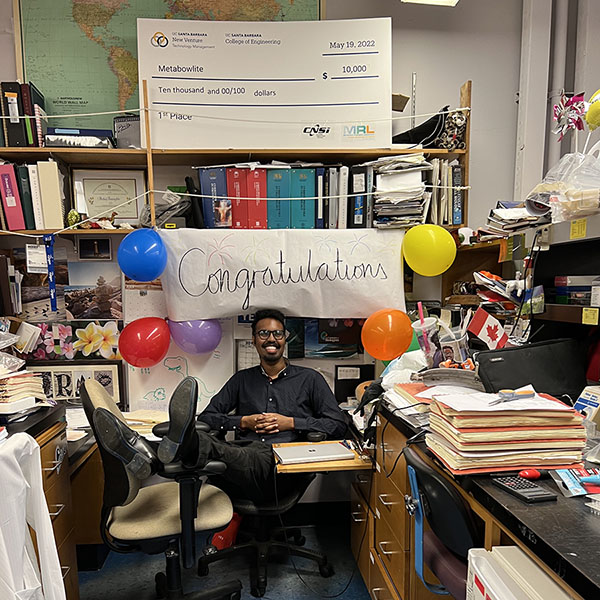by Kim Lamb Gregory
 Class of 2016 alumnus Mohamed Faynus and the scientists working with him are working with stem cells to combat blindness - and the results are looking good.
Class of 2016 alumnus Mohamed Faynus and the scientists working with him are working with stem cells to combat blindness - and the results are looking good.
“We completed a Phase I/2A trial,” Faynus said. “We started with patients who were legally blind. We’re excited about the results because 27% of the patients showed improved vision, and 60% either improved or remained stable.”
Faynus is part of a team at the Dennis O. Clegg Lab in the UCSB Center for Stem Cell Biology and Engineering developing stem cell technology aimed at combating blindness caused by so-called “dry” macular degeneration, which makes up the majority of macular degeneration diagnoses.
“Mohamed is just great in the lab,” Clegg said. “He is so curious about science and so hardworking and enthusiastic. He’s always full of ideas and new projects. It’s been a pleasure to work with him.”
Faynus said the feeling is mutual, and he is especially fond of the ballcaps Clegg gets for the research team at the Ventura County Fair each year. This year, the caps sported a giant eyeball.
Faynus became intrigued with the possibilities connected with stem cell technology through CSUCI’s Bridges to Stem Cell Research program, which is funded through the California Institute for Regenerative Medicine (CIRM). Launched by Professor of Biology Nitika Parmar, the program allows graduate students to get paid internships to study stem cell technology at prestigious medical institutions like Stanford University; the Scripps and Salk research institutes and the University of California research centers, to name a few.
“I am very proud of his achievements and am expecting him to conduct stellar research in the future as well,” Parmar said. “Mohamed has been one of our ‘star’ students and a great inspiration to all.”
Faynus’ family immigrated to Canada from Somalia when Faynus was five. He was always fascinated with science as a kid—especially bugs. When he finished high school, he enrolled in the University of Toronto and earned a Bachelor of Science (BS) in Forensic Science.
The day he wandered up to CSUCI’s booth at his schools graduate fair, he learned about the stem cell program Parmar ran in Southern California, more than 2,000 miles from his native Toronto.
He was sold. He relocated to Camarillo and enrolled in the Master’s of Biotechnology (MS) program at CSUCI. During the final year of his Master’s degree at CSUCI, Faynus did a stem cell internship at UCSB’s Dennis O. Clegg Lab, where Clegg and his fellow scientists were creating a of patch made of stem cell derived retinal pigment epithelial cells that could be implanted in the back of the eye of patients with Age-Related Macular degeneration.
When the retinal pigment epithelium or (RPE) cells are healthy, they enable photoreceptor cells of the retina to detect light, but when they begin to atrophy, it can lead to impaired vision or for many, blindness.
Faynus earned his Ph.D. in Biomolecular Science and Engineering from UC Santa Barbara (UCSB) this summer, and is now a post-doctoral fellow in the Clegg lab working part time for two different biotechnology companies.
“The capability of a stem cell is remarkable,” Faynus said. “With stem cell technology we can study human diseases in a dish —in this case, those that affect the retina. Maybe within the next decade or so we’ll see the next wave of therapy options reach patients.”
Photo courtesy Mohamed Faynus and Dennis Clegg: Mohamed Faynus in his office after coworkers decorated it to congratulate him on his Ph.D.
